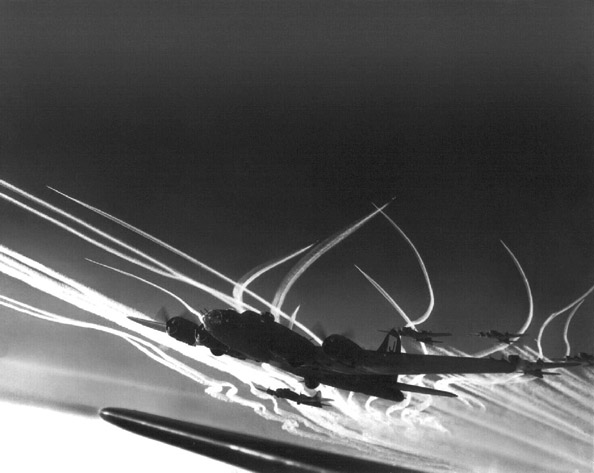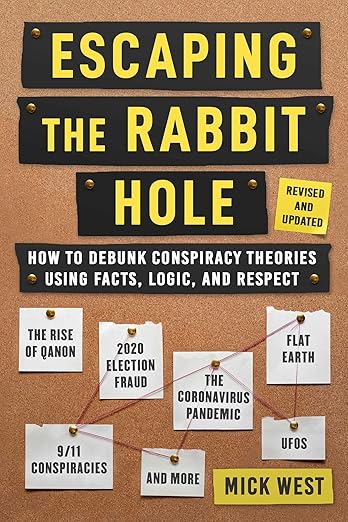There are lots of photos of contrails from World War II. I’ve collected a few of them here:
https://plus.google.com/photos/107393796095434664991/albums/5235534135256807809
The collection shows all types of contrail formation – from the very short ones, to long persistent trails that spread out like cloud cover.
Why so many photos of contrails in WWII, and not so many from the 50’s and 60’s? The simple reason is that contrails only form at very low temperatures, which are normally found at high altitude, and in peacetime there was NO REASON TO FLY THAT HIGH until the advent of commercial jet travel a few decades later.
The only reason these planes are flying that high is so they can avoid anti-aircraft fire. The bombers fly as high as they can, and then their fighter escorts fly even higher, so they can see incoming aircraft targeting the bombers, and swoop down to attack. This type of escorting is called “Top Cover”. The most classic example of this is the famous photo “Top cover over J-Group”:



Hi !
There the contrails & the chemtrails. This is true. There are test load on the aircraft. This is true. But, that said they pulvérisent water or orange juice? Which? That checks?
Aircraft land somewhere, where? Where are the photographs of the aircraft? Anonymous aircraft crossed on the tarmac?
An airplane is not a helicopter. It does not arise from the vertical. To land it descends. Photo?
How many daily flights between LA and Denver? How are the chemtrails?
________________________________________
Il existe des contrails & des chemtrails. C’est vrai. Il existe des tests de charge sur les avions. C’est vrai. Mais, qui dit qu’ils pulvérisent de l’eau ou du jus d’orange ? Qui ? Qui vérifie ?
Les avions atterrissent quelque part, où ? Où sont les photographies des avions ? Avions anonymes croisés sur le tarmac ?
Un avion n’est pas un hélicoptère. Il ne se pose pas à la verticale. Pour atterrir il descend. Photo ?
Combien de vols quotidiens entre LA et Denver ? Combien font des chemtrails ?
A blog article dedicated to contrails in WW2 – mainly revolving around olf Flight magazine articles but with some links to other studies during the era – http://airminded.org/2010/04/01/visible-vortices/
Makes an interesting read if you are of a rational state of mind.
Very nice article, thanks!
Here’s another article dealing with a lot of info on WW2 era contrails, including references to studies done befoer the war –
“Wakes of war: contrails and the rise of air power, 1918-1945 Part II-the air war over Europe, 1939-1945”
http://findarticles.com/p/articles/mi_hb3101/is_3_54/ai_n29372921/?tag=content;col1
Plenty of references to contrails expanding to make clouds, different experiences with Canadian pilots training in frozen conditions viz those in Europe, wingtip vs exhaust, etc.
(I’ll check if you’ve referenced Pt 1 in the Pre-WW2 section, and put a link there if there is not one already)
Here’s another article from 1943, found on Chemtrails Exposed facebook page
http://books.google.com.au/books?id=KCcDAAAAMBAJ&lpg=PA55&dq=popular+science+antitank+1941&pg=PA55#v=twopage&q&f=true
Thank’s Marcel, it’s actually already here:
https://contrailscience.com/why-planes-make-vapor-trails/
These planes are leaving smoke trails because they are oxygen starved. The exaust is full of smoke from the very lean burning of the fule which was gasoline. The Allied Forces used naturaly asperated carberaters up untill the last part of the war and they needed to perform vodoo mechanics on them just to get them to fly that high. Flying top cover wasn’t very effective against the Germans since they had fuel injection and could climb much faster and higher then the Allied Forces could at the time. But that said this has no bearing on Chemtrails.
Hi Jack. No sorry but that is wrong. Those planes leaving trails on both the allied or axis side were not significantly oxygen starved due to the extensive use of Superchargers. Air compressing Superchargers were standard for high performance aircraft right from the earliest days of ww2.
They had numerous types of superchargers that compress the air at altitude and allow the engines to run effectively.
The American B17s bombers had shaft driven turbo superchargers http://www.b17bomber.de/eng/details/turbolader.php
http://ships.bouwman.com/B17/Supercharger.html
British Wellington, Lancaster, Mosquito Hurricane, Spitfire etc bombers and fighters all had superchargers right from their introduction.
http://en.wikipedia.org/wiki/Bristol_Hercules
http://www.aviation-history.com/engines/merlin.htm
The German high altitude fighters and bombers all had superchargers as did the American fighter escorts.
Towards the end of the war the Germans also had operational gas turbine powered jet fighters and reconnaissance planes like the Me262 and the Arado 234 blitz
it’s just smoke! puffs of smoke! puff! puff! puff! just smoke, ‘lil puffs of smoke! puff! puff! puff!
You know that’s not what the science says. Have you actually looked it up?
Check this 1945 issue of Popular Science. It says it’s water vapor:
http://books.google.com/books?id=KCcDAAAAMBAJ&pg=PA55#v=onepage&q&f=false
Smoke? Just smoke?
Can’t be just smoke. It has to be PERSISTENT smoke.
Maybe there’s a patent for it.
I must say I really enjoyed the 4 hours reading through all the comments. Chemtrail? More like chem. fail! (if , by any chance, chemtrailers would’ve studied chemistry) Watch out for dragons!
And a merry christmas 🙂